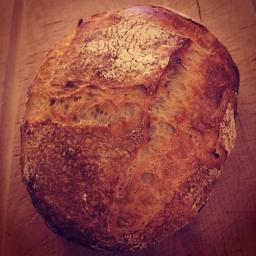Inspired by dmsnyder's post about Hamelman's Vermont Sourdough with Increased Whole Grain, and is recommendation of it to those seeking "a more sour sourdough" (sign me up!), I decided to make that my Sunday bake. Friday morning I refreshed my firm starter, and changed some of it to a 125% liquid starter, then made the preferment levain friday night, and was all ready to mix the dough Saturday morning.
What I did not realize, at first anyway, is that the amounts of ingredients in my printing of Bread are horribly, horribly wrong. The dangers of not consulting Hamelman's errata before making a new formula, I guess. The percentages, as given in the book, are supposed to be 85% bread flour, 15% whole rye, 65% water, 1.9% salt, with 20% of the total flour prefermented in the liquid levain, and is supposed to be based on 2lbs of flour. If you follow the home-baker amounts, however, you'd end up with 70% bread flour, 30% rye, 3.8% salt and a ridiculous 30% water, based on 1 lb of flour. If figured this out in stages.
It was pretty easy to figure out something was wrong when I did the initial mix and had a 4.8 oz. of water in 16 oz. of flour. Doesn't make much of a dough, funnily enough :P. So I add some more water to bring it up to 65% hydration. But something seemed off. The dough seemed kinda pasty. At this point it occurred to me to check the math on the rye percentage. I wasn't really wanting to deal with a 30% rye bread so I improvised, threw in more bread flour and water to make the bread to make 2lbs of flour with 65% hydration.
But then I only had 10% of the flour prefermented, and only half as much levain as the formula needed. Improvisation again! I still had about 4oz of firm starter in the fridge from the day before, so I threw about 3 oz in when I added the salt (the formula is made with an autolyze.
I ended up bulk fermenting for much longer than the 2.5 hours Hamelman calls for, more like 4 hours, and even then it seemed pretty sluggish. But I eventually went ahead and shaped two big loaves, placed them in brotforms and retarded overnight. I baked them this morning and...drumroll...
It actually worked! Great crumb, pleasant flavor. Not overly sour, but I imagine that will change when I have some for breakfast tomorrow. I got so much oven spring on the boule that I was sure there was just a single giant hole at the top and nothing else. I was pleasantly surprised, to say the least!




